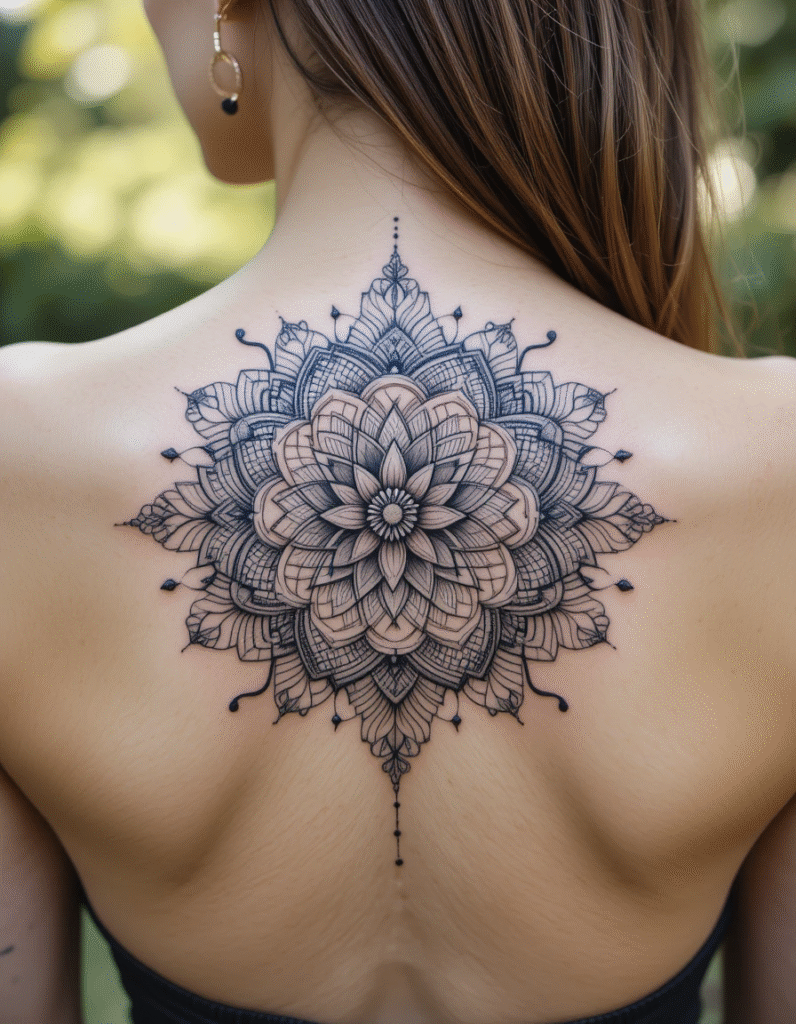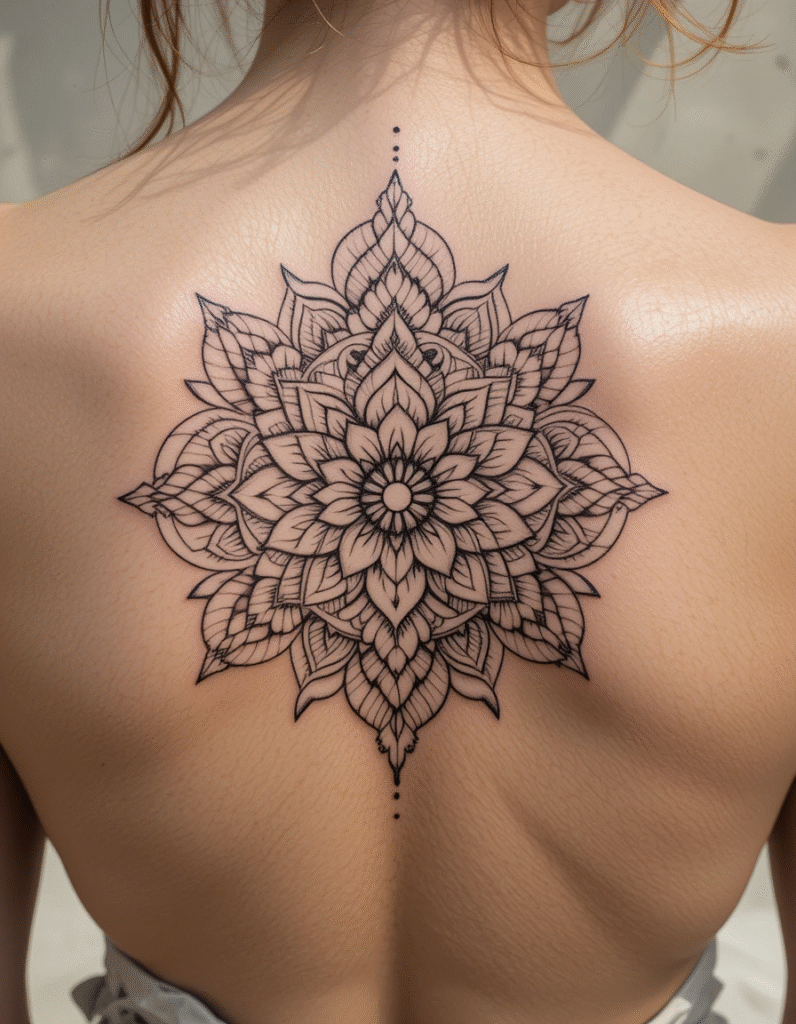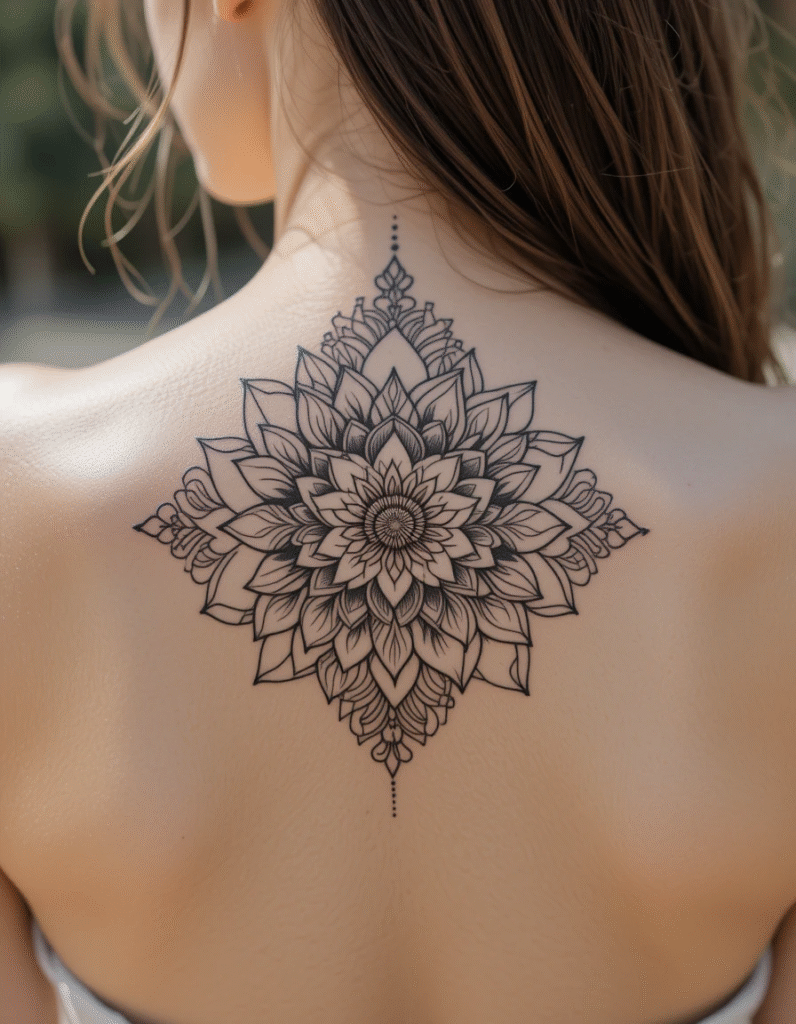In the realm of tattoo artistry, few designs capture the perfect balance between spiritual meaning and aesthetic beauty quite like the mandala. These intricate, symmetrical patterns have transcended their ancient origins to become one of the most sought-after tattoo styles in contemporary body art, offering wearers a deeply personal symbol of wholeness, balance, and inner peace.
The Ancient Roots of Mandala Art
The word “mandala” comes from ancient Sanskrit, meaning “circle” or “completion.” For thousands of years, these geometric patterns have served as sacred symbols in Hindu and Buddhist traditions, representing the universe, consciousness, and the journey toward enlightenment. When translated into tattoo form, mandalas carry this profound spiritual significance while creating stunning visual masterpieces.
The Perfect Canvas: Back Placement
The upper back provides an ideal canvas for mandala tattoos, offering the space needed to showcase the intricate details and symmetrical beauty of these designs. The natural curve of the shoulder blades and the expansive surface area allow artists to create large-scale pieces that command attention while maintaining the precise geometric integrity essential to authentic mandala art.

Masterful Line Work and Sacred Geometry
What sets exceptional mandala tattoos apart is the precision required in their execution. Every line must be perfectly placed, every curve must flow seamlessly into the next, and the overall symmetry must be flawless. The layered petals, intricate patterns, and geometric elements create a mesmerizing visual effect that draws the eye inward toward the central focal point.
The radiating design typically features multiple layers of increasingly complex patterns, each representing different aspects of spiritual growth and self-discovery. From the detailed center core to the ornate outer petals, every element serves both aesthetic and symbolic purposes.
Symbolic Elements and Their Meanings
Traditional mandala tattoos incorporate several key elements, each carrying its own significance:
The Central Point: Represents the self, the beginning of one’s spiritual journey, and the connection to the divine.
Geometric Patterns: The intricate mathematical precision symbolizes the order and harmony found in the universe.
Lotus Petals: Often incorporated into mandala designs, these represent purity, rebirth, and spiritual awakening.
Radiating Lines: These extending elements symbolize the expansion of consciousness and the connection between inner and outer worlds.
Dotwork Details: The precise stippling and dot patterns require exceptional skill and add texture while representing the infinite nature of existence.

The Meditation of Creation
Creating a mandala tattoo is often described as a meditative process for both artist and client. The repetitive, precise nature of the work requires intense focus and patience, mirroring the contemplative practices associated with traditional mandala creation. Many clients report that the tattooing process itself becomes a form of meditation, helping them connect with the spiritual significance of their chosen design.
Variations in Style and Approach
While maintaining the essential geometric principles, modern mandala tattoos offer endless variations:
Traditional Sacred Geometry: Focusing on precise mathematical patterns and spiritual symbolism.
Floral Mandalas: Incorporating natural elements like lotus flowers, roses, or other botanical motifs.
Ornamental Designs: Emphasizing decorative elements and intricate line work for pure aesthetic appeal.
Minimalist Approach: Simplified designs that capture the essence of mandala art with clean, bold lines.
The Personal Journey
Each mandala tattoo is deeply personal, often chosen during significant life transitions or periods of spiritual growth. The symmetrical nature of the design represents balance and harmony, while the circular form symbolizes wholeness and completion. For many, wearing a mandala serves as a daily reminder of their spiritual journey and commitment to personal growth.

Technical Mastery Required
Not every tattoo artist possesses the specialized skills needed for exceptional mandala work. The style demands:
- Perfect symmetry and proportion
- Steady hand control for precise line work
- Understanding of sacred geometry principles
- Patience for detailed stippling and dotwork
- Ability to maintain consistency across large-scale pieces
Placement Considerations
While back pieces offer the most dramatic impact, mandala tattoos can be adapted for various body placements. The key is ensuring the design maintains its proportional integrity and symbolic meaning regardless of size or location. The flowing nature of mandala designs makes them particularly well-suited to body contours, creating a harmonious relationship between art and anatomy.
A Timeless Choice
The enduring appeal of mandala tattoos lies in their ability to combine profound spiritual meaning with stunning visual artistry. They represent a convergence of ancient wisdom and modern expression, creating wearable art that serves as both personal talisman and artistic statement.
For those drawn to the spiritual significance, the mathematical beauty, or simply the aesthetic appeal of geometric patterns, a well-executed mandala tattoo offers a timeless choice that will continue to inspire and captivate for years to come. In a world of changing trends, the mandala remains a constant symbol of balance, harmony, and the eternal human quest for meaning and beauty.


